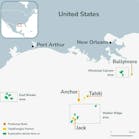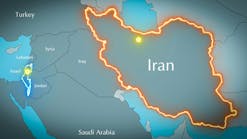Robert Zinke, Jerome G. MorseHydrocarbon anomalies, as many reported, can be qualitatively and directly identified from radiometric measurements. Further evidence is seen in the results of processing and contouring NURE airborne data acquired at three established oil fields: Wilson Creek in Colorado; Bell Creek in Montana; and Sorrento-Rhoades-Sianna in Colorado.
Colorado School of Mines
Golden, Colo.
NURE is an acronym for National Uranium Resource Exploration program, a comprehensive Department of Energy 10 year effort, now complete, during which the conterminous U.S. and parts of Alaska were surveyed for uranium values.
In this article, we demonstrate for these oilfields the extent of correspondence of radiometrics, particularly when contrasted with known production. Figs. 1 (WC) [29324 bytes], 2 (BC) [62328 bytes], and 3 (SRS) [49946 bytes] are derived from data reported solely in the total count window (0.3 to 3.0 MeV), and compared with drilling results at these locations. Later in the text, we explain the basis for selecting the total count window.
Geology of the fields
Combined, the Morrison and the Entrada have produced 84.5 million bbl of oil and 66.8 bcf of gas. Maximum oil zone thicknesses are 98 ft for the Morrison and 156 ft for the Entrada. The field has approximately 300 ft of structure above the oil-water contact in the Entrada. The Morrison pay is a white to pale green quartzose sandstone, fine and generally well sorted, whereas the Entrada pay is white fine orange tan quartzose sand, also well sorted. Both pays are bonded with calcareous and argillaceous cement. The Morrison sand is approximately 200 ft in thickness overlying the 430 ft thick Entrada. Production depth ranges from 6,650-6,800 ft.1
Contoured total count data (NURE) locates in Fig. 1 an anomaly (low gamma flux) associated with the oil field. Differences in contoured counts per second (cps) range from a high of 1901 to the south through 1311 in the anomaly's center, increasing to 1922 cps to the north-a variance of approximately 600 counts, or 31% change. The anomaly is shifted slightly north of the oil field, a shift that may be caused by ground water flow carrying the hydrocarbon chimney or plume north of its source.
From the processed NURE data, seen in Fig. 2, an anomalous gamma low appears over and associated with the oil field. Reflecting the general shape of the field, the anomaly is situated slightly east of the oil field. Total count values varied from a high of 2854 cps in the east, decreasing to 2272 (the hydrocarbon anomaly), and rising to 2758 cps in the west, indicating an 18-20% count reduction.
The NURE data, flown at approximately 5 mile spacings between east-west flight lines, crossed only the Sianna portion of the oil field complex. However, the influence of an oil field hydrocarbon chimney or plume can be seen in the western Sorrento portion of the complex, on the flight line data north and south of the oil field complex. The variation in total counts, shown in Fig. 3, ranges from 4100 cps to the south through 3500 cps in the Sorrento area to 3700 cps to the north, from 15% down to 5%.
Data reduction, analysis
Total count: The NURE program's earth-looking gamma spectrometers measured terrestrial gamma ray responses in three narrow energy windows and as total counts. For example, the uranium spectral range was set at ~1.7 MeV; thorium ~2.6 MeV; potassium ~1.4 MeV; and total count window, which integrated all energy responses, between 0.3 to 3.0 MeV. For reasons of effective counting statistics, we believe using total count data as opposed to considering the far smaller reponses collected in the narrower energy windows.
Over Bell Creek,4 the average count rates measured for the primordial elements uranium (U), thorium (Th), and potassium (K) ranged from 40-150 cps, while that collected in the total count window showed on average 2,600 cps. Counting statistics determine a Measure of Uncertainty, which is defined at the relative probable error (RPE), for each NURE window.
RPE equals 1/N, where N is number of counts.5
Error magnitudes range from 8-16% for primordial elements, whereas for total count, the RPE is 1.9%, a rather significant reduction in uncertainty.
However, correlating low gamma counts in petroleum basins with possible presences of hydrocarbon accumulations is less simple to explain. Consideration must be given to surface and subsurface geology, surface conditions such as vegetation and the shielding effect of surface waters. Geochemistry makes plain the contributions of subsurface water movement, formation faults, bedding planes fractures, or permeable and impermeable layers of sediment on forming hydrocarbon microseep chimneys or plumes perceived above oil and gas deposits. We propose introducing physics to aid in understanding why radiometrics is viable as an exploration tool.
Low gamma counts detected in petroleum basins signal potential subsurface oil and gas accumulations, support Laubmeyer's6 vertical migration hypothesis as it applies to oil and gas reconnaissance, and Morse and Zinke's7 model suggesting how hydrocarbons influence gamma radiation detected at the surface.
Contouring total count "lows," as illustrated in Figs. 1, 2, and 3, correlate well with productive drilling. But contouring individual window data from the same fields, related poorly or not at all and will be the subject of a future article.
The gamma flux, as stated earlier, is derived primarily from three primordial radionuclides. Examining their individual geochemical and geophysical behavior in petroleum basins may help to explain the results we found, but the roles each plays in hydrocarbon exploration could, and should, be established through additional research.
Uranium and thorium
Commonalities: These two radioelements father individual natural decay series, chains of disintegrating radioactive events that produce in each series different radium isotopes, terminating as nonradioactive or stable lead isotopes. The radiums breakdown into radon, the only gas formed in either chain. Each radon, on further decay, forms the major sources of gamma rays we detect and measure in the field.
Differences: Thorium is found solely in the tetravalent state (Th+4) while uranium occurs in two states: tetravalent (U+4) and hexavalent (U+6).
Hexavalent uranium, soluble in oxidizing environments, and moreso when the waters are complexed by carbonate or sulfate, the two main components of natural waters,8 converts to its tetravalent state in a reducing environment, and becomes insoluble. Thorium, existing only in its insoluble tetravalent state, is influenced neither by reducing nor oxidizing environments.9
Potassium forms chemical compounds only as a monovalent positive ion. In the earth's crust, potassium is about as abundant as sodium though commonly less than one tenth the concentration of sodium in natural waters. Potassium's immobility is ascribed first to the fact that it readily combines with clay and clay-like minerals, forming stable chemical structures, and second, many potassium minerals resist weathering. All natural waters have measurable amounts of potassium, with most potable waters ranging in concentration between 1.0-5.0 ppm. Commonly dilute waters containing 20 ppm of total dissolved solids may contain about 2 ppm potassium. As the concentration of solids increases, the amount of potassium increases only slightly. Water with 2,000 ppm dissolved solids will probably have less than 20 ppm potassium.10 Gamma ray emissions from potassium in the earth's crust mostly will be related to the presence of clay and clay-like minerals, and to potassium salts, such as KCl in subsurface and surface waters. Local amounts of clay and clay-like minerals are subject to geologic interpretation. The observed low variation in concentration of potassium salts in surface and near surface waters explains their small variation in gamma ray emissions.
Hydrologic cycle
Continuous circulation of moisture and water in the earth and its atmosphere is called the hydrologic cycle, with the waters of the oceans, lakes, and the earth's surface providing moisture through evapotranspiration. Collecting to form clouds, the moisture condenses to cause rain and snow and completes the cycle by reentering the soil or flowing into surface drainage. Water penetrating the soil becomes ground water where it can be drawn by gravity into the water table, or it can be raised to the surface by capillary forces and evaporated into the atmosphere by taking a shorter route in the hydrologic cycle, or lastly it can be absorbed by plant roots and transpired into the atmosphere through plant leaves and stems.11
Model's influence
The model we describe depends primarily on three factors: a near-surface chemically-reducing environment caused by deeper hydrocarbon microseeps, and the physical and chemical behavior of uranium, thorium, and potassium in that environment.
Reducing environments are created by the microseepage of migrating hydrocarbons. Subsurface waters carrying water-soluble hexavalent uranium salts are the source of surface releases of radon gas (Rn-222), which undergoes radioactive decay to form the gamma ray emitters detected from NURE airborne platforms. Similarly, radon gas (Rn-220), produced in thorium decay, also emits NURE-detectable gamma rays. Potassium emits gamma rays directly.
Since hydrocarbon-induced reducing environments affect only uranium, subsurface waters carrying soluble hexavalent uranium, on encountering an area of soil and sediments bearing hydrocarbons, reduces the uranium to its insoluble tetravalent state. The latter precipitates and remains in place, often releasing radon-222 too far from the surface to be detected from an airborne platform. Thus the atmosphere above soil and sediments containing hydrocarbons will produce lower levels of Rn-222 and consequently a reduced total gamma ray flux. This became readily apparent when contouring total count gamma ray NURE data in each of the three oil fields studied.
Although thorium and uranium each form a radon isotope in their decay series, we stress the differences between the two.7 Reviewing their relative diffusion lengths in soil, their contributions to the surface gamma flux, the crustal abundances of parent uranium and thorium, and their specific radioactivities, we find:
Rn-222's (U-238 decay series) half life is 5,000 times longer than that of Rn-220 (Th-232 decay series), making the average diffusion length of uranium's radon 100 times greater than that of Rn-220.12 This variance is non-trivial when assessing the parent radionuclide's contribution to the surface gamma flux. Despite the fact that the relative abundance of Th-232 may be as much as four times greater than that of U-238, the specific radioactivity of the latter is greater than that of Th-232 by at least a factor of two.
Therefore, we assume conservatively that Th-232 must locate about 50 times closer to the surface for the two radons to contribute equally to the gamma flux. These factors, although far from being conclusive, may help to explain uranium's vital role in radiometric exploration for oil and gas.
References
1. Gibson, H., Wilson Creek Field, in RMAG Oil & Gas Field Volume, Colorado-Nebraska, edited by J.M. Parker, Rocky Mountain Association of Geologists, Denver, 1961, pp. 258-259.
2. Haddenhorst, F.A., Development History-Bell Creek Oil Field, Powder River County, Mont., June 1967 to July 1968, JPT, Vol. 20, No. 8, 1968, pp. 787-793.
3. Sonnenberg, S.A., McKenna, D.J., and McKenna, P.J., Morrow Sandstone of Southeast Colorado and adjacent areas, edited by S.A. Sonneberg, L.T. Shannon, K. Rader, W.F. Von Drehle, and G.W. Martin, Rocky Mountain Association of Geologists, Denver, 1990, pp. 81-89.
4. Ekalaka, Ekalaka Quadrangle, Department of Energy, Washington, D.C. NURE report GJBX-82(79).
5. Lapp, R.E., and Andrews, H.L., Nuclear Radiation Physics, Prentice-Hall, New York, 1948, p. 233.
6. Laubmeyer. G., A new geophysical prospecting method especially for deposits of hydrocarbons, Pet., Vol. 9, No. 18, 1933, pp. 1-4.
7. Morse, J.G., and Zinke, R., The origin of radiometric anomalies in petroleum basins-a proposed model, OGJ, June 5, 1995, p. 36.
8. McKelvey, V.E., Everhart, D.L., and Garrells, R.M., Origin of uranium deposits, Econ. Geol., 50th anniversary volume 1905-1955, Economic Geology Publishing Co., Lancaster Press Inc., Lancaster, Pa., 1955, pp. 464-533.
9. Saunders, D.F., and Potts, M.J., 1978, Manual for the Application of NURE 1974-77 Aerial Gamma Ray Spectrometer Data, Department of Energy, Washington, D.C., report GJBX-13 (78).
10. Davis, S.N., and DeWiest, R.J.M., Hydrogeology, John Wiley & Sons, N.Y., 1966, pp. 106, 159.
11. Johnson, E.E., Ground Water and Wells, E.E. Johnson, Inc., St. Paul, Minn., 1966, pp. 15, 16.
12. Tanner, A.B., Radon migration in the ground, in The Natural Radiation Environment, J.A.S. Adams and W.M. Lowder, editors, University of Chicago Press, Chicago, 1964.
The Authors
Robert Zinke works as an independent consulting geologist, primarily in petroleum exploration. Additional, he and Jerome Morse in recent years jointly developed unique applications of radiometrics to find oil and gas, forming with others Gamma Search Inc., of which Zinke is president. He has a BS in engineering geology from Missouri School of Mines.Jerome Morse is research professor of physics at the Colorado School of Mines. Since publishing "Nuclear Methods in Mineral Exploration and Production," he has applied radiation measurements to searching for oil and gas.
Copyright 1996 Oil & Gas Journal. All Rights Reserved.


